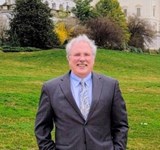70 years of Hope: Organization celebrates decades of serving the diverse abilities community
July 25, 2022
It was the early 1950s when a group of parents and community leaders came together to help each other navigate the world of caring for children with diversabilities. The effort was spearheaded by Dr. Max E. Miller and his wife Leona.
“We started in 1952 and there was a group of eight and it was basically like, ‘how can we support each other?,” said Robert Labatch, president and CEO of Hope Enterprises Inc.
Classes for children and adults were held in a church basement until in 1958 a building was constructed on Catherine Street in the East End of the city. This became the “School of Hope” for families who up until then had few options for caring for their loved one. Labatch pointed out that there were a lot of “chocolate chip cookie donations and all those things” in order to get money to fund the school because there was no federal funding. Everything was really in the hands of the family with the child with special needs.
“There was no public education. If you had a child with diversabilities, you were basically putting them in an institution or they were living, really, in your basement,” Labatch said.
“They really solidified things with having the preschool and the pre-services. What they looked at is they knew that if you started with early intervention and you were working with families, then you can work a continuum of care,” he said.
“That’s why Catherine Street was such a big monumental thing because they were able to put bricks and mortar to this. They started the School of Hope and that kind of solidified the start of services and support for folks in the community,” Labatch said.
In 1962, increased enrollment resulted in an addition being built onto the original School of Hope building but there still was not an avenue for children with diversabilities to enter the educational system.
“Early intervention kind of got folks involved in the education system and really working in the pre-school and then kindergarten ages. Hope in the early years kind of worked with the school districts at that point,” Labatch said.
Then in the 1970s everything changed in terms of educating and caring for people with diversabilities. More federal and state funding became available as the government called for deinstitutionalization of people with intellectual disabilities.
“We finally got up with the times and said we need to do so. At that point Hope was able to provide post-graduation types of things and services for transitional youth,” Labatch said.
“That really helped with staying involved in the child and the family’s life through the stages. Hope always wanted to be a support to the family but not drive the services. There are all unique needs-they’re all different. Some folks need a lot more medical services, some just need more companion services. So, you really had to build what was the level of need,” he said.
During this time, Hope worked with parent groups in the community to try to determine gaps in services.
When institutions were closed, the federal government gave money to the state which in turn gave it to communities to build services and support for people.
“You took an institution which had thousands of people and then you made smaller, smaller homes in the community,” Labatch said.
At that point group homes with 15 to 16 beds were established in the community in order to decentralize.
“We weren’t at the point where we were actually individualized,” he said.
In the early years of Hope, there had been an emphasis on bricks and mortar types of services. When the institutions closed the focus changed.
“What they really said was, the federal government and the state government are going to give dollars to the communities to build services and supports for people,” Labatch explained.
At that time Hope established group homes with maybe 15 to 16 beds to meet the needs of the community.
“What people did was, if they went to a group home, they went to an adult training facility…and then you had vocational services. We had a sheltered workshop where folks that were more vocationally driven could go and then maybe more of our behaviorally or medically challenged went to more of an adult day program,” he said.
Through the years, Hope offered the sheltered workshops and worked with the school districts to have vocational services for the students.
“That tied us into the later years of high school. Then we had early intervention services and daycare that brought people through,” he said. “You kind of had that connection.”
Speaking of the group homes that once existed, Labatch said,“Those have evolved over the last 25 years to be just one to two people, three people.”
“Today there’s a lot more. We’ve grown as a society. There’s a lot more support. Public education is light years from what it was in the 70’s, so Hope doesn’t necessarily need to do all of those things for the education system,” Labatch noted.
“So, as the school grew and provided more services, then Hope took their services and they evolved some of the after-school or the post-graduation things with job-coaching and those kinds of things,” Labatch said.
He pointed out that Hope’s focus now is more on the transitional youth age group, those that are 15-years-old and up.
“I think what’s happened is that through the 70 years of our inception is that the innovation of all of my predecessors and the organization to just look at what the community needs-what the population needs-and then evolving to what that is,” Labatch said,
“Always listening to what people’s needs and their wants are, what they need out of a service,” he added.
Today there is the Office of Vocational Rehabilitation and other services offered to the diverse abilities community.
Hope offers residential services. They have what they call choice services, which is an array of individualized or group services such as home health services, companion services which are more of the social-recreational. There is also job coaching and job assessment, where there’s short term job skill assessment.
“We really focus on training folks in an environment where they’re going to work. In the past we had the sheltered workshop where you would only be with folks with disabilities. It would be a very closed group,” he said.
“Over the years, we find, just like in public education, integration and inclusion is the way people find friendships-they find natural supports,” he said.
For example, Labatch explained that if a person with diversabilities works at a local grocery store or restaurant, there is job coaching and job assessment within that community setting.
“We’re doing on the job training rather than trying to simulate something someplace else,” he said.
“The local community has been wonderful. Some people have made special accommodations for us because they know that the person is working and supporting and they have a Hope staff there,” he added.
The impetus for offering choice services to families is the ability to build a relationship with families.
“What we’ve tried to do is get to know all about the family. We want to build a relationship and then we want to talk through what those services are. We want to take all the confusion away from the family,” he added.
Labatch admitted that Hope is still very much on the cutting edge with the choice services program.
“No longer having a sheltered workshop but doing everything community based. There are still a lot of people that are still doing a lot more segregated types of things,” he said. l
With the acquisition of the Children’s Development Center, Hope was able to expand their preschool services which had existed at the Catherine Street site.
Labatch said that at the Children’s Campus Hope has a preschool where they have partnered with STEP which runs a couple of classrooms for their early Headstart and Headstart programs.
The Women’s, Infants and Children’s (WIC) program office, which serves two counties, is located there.
Labatch attributes the partnerships that Hope has with other nonprofits as one of the reasons for their success.
“We’ve not tried to do this alone. I think it started as an initiative of being like 12 parents, like hey, I need this for my kids-I need to do this. But, I think it was the partnerships and also the community embracing it,” he said.
“I’ve visited a lot of places across PA, and the communities tell you a lot, how they support and how they work together. But, I think the innovation and then the community partnerships are what has made us successful for 70 years and I think that those will be what continues to grow us for the next 70,” he said.


